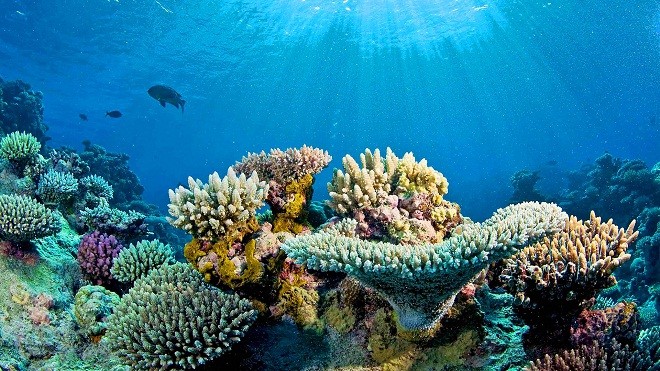Not all the coral reef in the world is in bad condition. Thanks to human effective methods, many marine life, resources and coral reef have been regenerated. The method for regeneration of coral reef to recover marine life and creatures which has been applied in Viet Nam since 2003 is one of such effective methods.

Building house for marine creatures
A comparison is made with the existing coral reef in the region and the latest studies by the scientists shows that Viet Nam is listed among countries and territories that have the most coral reefs being threatened, in addition to the Philippines, China, Taiwan and Indonesia. After surveying more than 200 points with coral reef in coastal areas of Viet Nam, scientists concluded that for about 10 years, coral reef coverage has been undermined significantly.
In order to minimize impacts from human activities on coral reef and marine resources, countries in the world have applied many different measures. Artificial coral reef is a technical solution that is highly appreciated by scientist in the protection, regeneration and development of marine resources.
Artificial coral reef refers to the construction of houses for coral reef within a sea water zone to provide accommodation for fish, using natural or artificial stuff that is installed into the sea bed in order to change physical and oceanic conditions, giving a habitat for fish to live in and a media for coral reef to recover.
Artificial coral reef can be made using many different types of material, building from old train cars, old cars, sunken ships, trees or even waste tires. Nevertheless, most of artificial coral reefs are built from precast concrete blocks with appropriate space for marine creatures to live in.
Regeneration and protection of marine resources
In 2003, the Institute of Oceanography pilot implemented the transplanting of coral reef on rigid media (artificial coral reef made of concrete) in Hong Ngan, Binh Dinh province. From 2006 – 2008, transplanted coral reef on 20 artificial concrete media in Nui Thanh (Quang Nam province). The results of pilot transplanting of coral reef after one year show a high rate of development at 82.5% and the growth rate of 5 – 6 cm/year.
Research results also affirmed the transplanting of coral into artificial reef is one of the most effective methods for recovering coral reef and increasing marine resources. Artificial coral reefs installed in the seabed could function as a very good media for coral to live in and develop in the context that natural coral reef in that region is undermined or dying out due to sedimentation.
In addition, artificial reef also provides ideal habitat for other marine creatures to live in such as Mollusca, Echinodermata, Starfish, Holothurian and other creatures such as coral reef fish, Crustacean to live in the coral reef or take the coral reef as protective shelter.
High potential
Recently, the scientific thesis “Development of artificial coral reef in Nha Trang bay” managed by Master of Science Nguyen Van Nhuan (Institute of Marine Science and Fishing Technology – Nha Trang University) has opened up good possibility of regenerating and protecting coastal marine resources.
During the implementation of the thesis, the research team examined, designed and released 150 concrete coral reef pieces with the seabed area of 10.000m2, sea water volume of 50.000m3 in the eastern sea water of Vinh Hoa ward (Nha Trang) to develop the model.
Surveys conducted before releasing the artificial coral reef to the sea, this sea zone is poor in terms of marine creatures, with only 28 fish species, belong to 19 families and 5 populations, mainly available in small size and average density of 8 - 9 head/m2. However, after the transplanting of artificial coral reef to the sea, the density and number of marine creature species at and around the coral reef has constantly been increasing over time.
For example, after 2 months (7-2014) surveys show a fish density of 57 head / cluster and after 1 year (6-2015) the fish average density reached 1.463 heads /cluster. The marine creature species are reported to be 91 species, belong to 36 families and 10 populations. As compared with before releasing the artificial coral reef, the fish species here has increased 3 times; most of these fish species are characterized by their residence near coral reef. The above said thesis was evaluated as highly feasible for the regeneration and protection of coastal marine resources in Nha Trang bay during actual implementation.
All the tests show that releasing artificial coral reef is a good direction that helps to recover coral reef ecosystem, biodiversity, and marine creature species in Viet Nam.